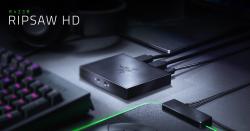 Razer Ripsaw HD Capture Card (Hardware)
Razer Ripsaw HD Capture Card (Hardware)
Official GBAtemp Review
Product Information:
- Official Store: https://www.razer.com/gaming-broadcaster/razer-ripsaw-hd
With every passing week, watching videos about video games gets more and more popular: Twitch has streamers who make tons of money through subscriptions. YouTube has Let’s Players who have been around since the dawn of the site. Mixer is attempting to grab fan favorite commentators to draw viewers to their service. Without a doubt, game streaming is something that a lot of people are drawn to. For those that desire to get into streaming their own gameplay, well, the first tool you’ll need is a good capture card.
Most capture cards, such ones made by Avermedia or Elgato require you to install the card into your computer’s PCIE slot. Instead of going that route, the Razer Ripsaw HD is a simple little box that you can plug your HDMI connections into and stream at 1080p 60fps.
On the front of the device are two 3.5mm aux inputs, one for audio in, and the other for audio out. This means if you want to, you can plug your microphone right into the capture card, as well as your headphones, to keep your audio sources all set to one device, and not confusingly spread across varying options in your streaming software. The caveat is that it requires having a 3.5mm microphone and headset, neither of which I use by default (both are USB). I can see being an issue for many people who likewise may not have 3.5mm connections on their hardware. For those fortunate enough to primarily use that kind of setup, it actually functions quite well, allowing you to use an audio mixer from the Razer Synapse application to easily make any changes to your sound. Turning the Ripsaw HD around shows three more ports: a USB-C input for power, and two HDMI connections, one for input, and another for output to a separate monitor.
One of the main selling points of the Ripsaw HD would be as a plug and play simple solution for those wanting to get into game streaming for the first time and possibly lacking enough experience to install a PCIE capture card on their own. However, that’s where you start to notice the flaws, especially when compared to the competition. And once you notice those issues, they quickly begin piling on, creating a much more needlessly annoying experience.
There were too many frustrations and complications involved in just getting the capture card to, well, capture. It’s an exercise in patience and fiddling with settings awkwardly, until something actually shows up. In most cases, I’d want to stream my Nintendo Switch, but OBS and Xsplit would show a rapidly-flashing screen, colors all melting together in some unexplained issue. Almost every time I’d open OBS, it would be unable to recognize the capture card. I’d have to go to add a new source, mess with multiple framerate and encoding settings, and just when I would be on the verge of giving up, the capture would spring to life and actually function for once. Bafflingly, opening the Razer Synapse software (used to install the corresponding driver), starting OBS, adding a new video capture source, and then force-ending the process for the Razer software was the best way to get the card to show up in OBS, although even then, it didn’t always work.
(Persona 5 Royal with sound captured via HDMI)
Capturing audio was equally as convoluted, with the capture card refusing to accept any form of sound output, unless it was routed back to my headphones, and then played at a delay as desktop audio. Sometimes, selecting audio output repeatedly would make the capture card work, at random. The only reliable solution was to get the aforementioned 3.5mm cord, and route it from Ripsaw to the aux plug on the back of my PC. It worked, but I still would have preferred being able to actually select the output via HDMI instead.
(Animal Crossing New Horizons with sound captured via 3.5)
Since Razer offers no software to actually keep track of your capture card outside of a simple audio mixer--unlike its direct competitor, Corsair’s Elgato line--you’re pretty much left struggling in the dark, when it comes to troubleshooting any issues. That also means you can’t watch the capture on your computer, unless you’re viewing it through the delayed preview on your streaming software. If you’re looking to play your consoles on your main monitor while still being able to use your PC, you won’t get that benefit here.
Despite all the problems that the Ripsaw brings to the table, when it actually does function, it does its job well. Recordings taken at 1080p look fantastic, and the video quality for both PlayStation 4 and Nintendo Switch streams is great. I also found that it worked superbly for recording old home recordings on VHS via a component to HDMI adapter.
Had the Ripsaw not been bogged down with so many complications, it could have easily been one of the best capture cards on the market. Retailing at $159.99, though, means there are many more affordable and easier to manage options out there, and unless you absolutely need an external card, or 4K passthrough appeals to you, the Razer Ripsaw HD fails to stand out.
Verdict
- When it does capture, the quality is actually pretty nice
- Allows for 4K 60fps passthrough
- No included software suite
- Is an absolute struggle to set up, on a constant basis
- Neither OBS nor Xsplit can reliably recognize HDMI audio output from the card




